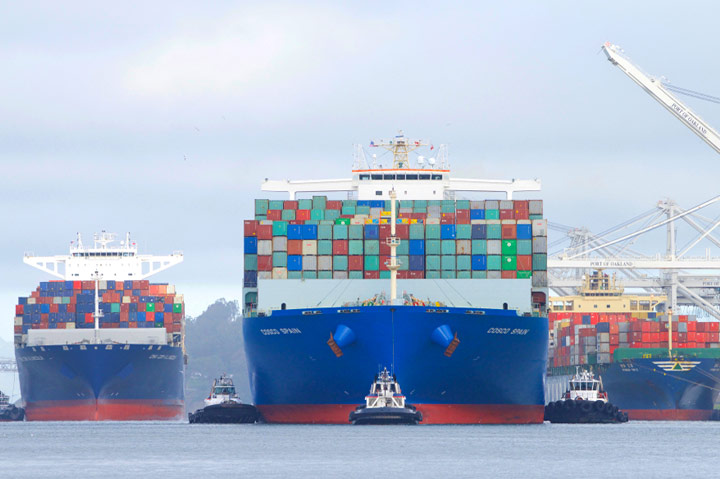News October 27, 2021
Port Congestion Worsens Despite Relief Attempts
New fees are being imposed to help get cargo moving, but some fear transport companies will pass the costs along, further driving inflation at retail and in promo.
The port congestion that’s contributing to inventory shortages at retail, in the promotional products market and other industries shows no signs of abating.
On Tuesday, Oct. 26, the twin ports of Los Angeles and Long Beach had 105 cargo ships waiting at anchor or in a holding area, according to the Maritime Exchange of Southern California. The numbers mean the situation has deteriorated, as the previous Tuesday there were 96 such ships.

Of the vessels stuck in the Oct. 26 logjam, 77 were container ships carrying hundreds of thousands of units of imported goods. The ports of Long Beach and Los Angeles process about 40% of the imported cargo containers that enter the United States.
The logjams are occurring at other U.S. ports, too. Goldman Sachs reported this week that more than 30 million tons of cargo is sitting on ships idling at American ports, waiting to unload.
Economists for the investment bank, like other supply chain experts, predict the port congestion will persist into the second half of 2022.
The port bottlenecks have continued a couple weeks after President Joe Biden announced measures aimed at alleviating at least some of the congestion.
Those steps include having the Port of Los Angeles operate 24 hours a day, seven days a week, and undertaking initiatives with retailers and carriers like FedEx and UPS with the goal of getting imported goods flowing more efficiently through U.S. ports, onto trucks and rail lines, and ultimately into warehouses and stores.
At the 2021 ASI Power Summit, experts discussed the supply chain situation and what promo distributors and suppliers can do to best navigate it.
Biden had said he would consider activating the National Guard to help with port congestion, but his administration later dampened the assertion. “We are not actively pursuing the use of the National Guard on a federal level,” the White House said.
In another effort to get cargo moving out of port quicker, the ports of Los Angeles and Long Beach announced this week that they would charge cargo carriers $100 for each container that remains on the dock for more than three days if it’s scheduled to be transported by rail.
If the cargo is to be moved by truck, then carriers will have nine days before the penalty fee takes effect. If the cargo continues to occupy dock space, the fee will increase by $100 per container per day.
“With the escalating backlog of ships off the coast, we must take immediate action to prompt the rapid removal of containers from our marine terminals,” Port of Long Beach Executive Director Mario Cordero said in a statement announcing the charges. “The terminals are running out of space, and this will make room for the containers sitting on those ships at anchor.”
Still, some importers are concerned that carriers will simply pass the fees along, further driving up the already increased cost of transporting goods once they’re on American soil. That potential cost increase for transport could ultimately ripple down the supply chain, further driving inflation everywhere from retail to promo.
The “decision to apply new surcharges does not resolve our ever-worsening supply chain crisis and we fear carriers will see this as another opportunity to stick shippers with the bill on top of already massive freight costs,” Stephen Lamar, president of the American Apparel and Footwear Association, said in a report from The Washington Post.
Got 1 minute? Then you can get the basics on what's causing inventory shortfalls & rising prices in the #promoproducts industry with this vid. More depth? Read: https://t.co/rTZceaX0dP @Melissa_ASI @Tim_Andrews_ASI @ASI_MBell @asicentral pic.twitter.com/N7aT0U7TY5
— Chris Ruvo (@ChrisR_ASI) June 8, 2021
In another emergency tactic meant to help unclog America’s ports, Long Beach recently announced a 90-day change to its zoning laws. For the next three months, warehouses and container yards can stack shipping containers four high, rather than two.
The port congestion is occurring for a variety of reasons.
At the root is a shift in consumer spending that was ushered in by the COVID-19 pandemic. These days, Americans are spending less on services – vacations, drinks at the bar – and more on goods. Overall, consumers are purchasing 15% more goods/products than they did in early 2020. Many of those items – including the vast majority of promotional products – are produced overseas, particularly in Asia. That’s led to a surge in importing that’s overwhelmed the supply line infrastructure.
Insufficient labor at the ports and in the transport industry are other oft-cited reasons, though some who work in trucking and at the ports say it’s not as simple as that. For instance, a YAHOO! Finance report quoted a port worker who said, among other things, that certain port protocols are tying operations in knots.
